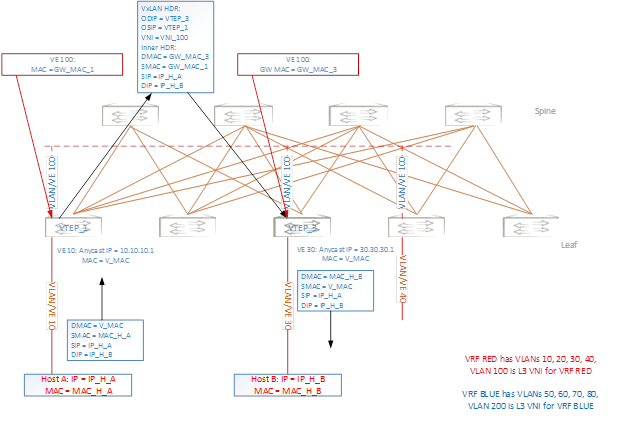EVPN-based VXLAN Layer 3 gateway
EVPN VXLAN-L3GW functionality support is one of the several key features under the larger umbrella of IP Fabrics.
The following sections describe two features for Layer 3 routing.
IP-MAC routes on a single VTEP
Similar to the normal MAC routes that are exported and installed by EVPN BGP extensions, IP-MAC routes are also exported and installed on the remote nodes. The components of this scenario are detailed here.
BGP MAC/IP routes
This kind of route represents L3-to-L2 mapping, which is basically through ARP or ND. Static, dynamic ARP/ND entries are both exported to remote PEs and get installed as host routes. IPv4/IPv6 addresses that are configured on VE interfaces are also exported.
Upon ARP learning/gleaning/snooping on a local PE, ARP/ND information is exported to its EVPN BGP peers. The information mainly includes the following: MAC, IP/IPv6, L2-VNI, and L3-VNI. Such imported ARP/ND routes are installed or withdrawn as host routes in the hardware on the remote nodes. In the control plane they are available through the ARP suppression cache, which could be further used to reply for further ARP requests from hosts attached to the remote PE.
The packet path is as follows:
- When traffic that is bound to a remote host is received on the ingress PE GW, no ARP request is generated, as the route table already has the hardware host entry to forward or route the traffic to the destined host. This situation prevents ARP flooding and further processing.
- Packets get routed on the ingress PE itself, and then are switched all the way to the destination host, through the egress PE. Because routing occurs on the ingress PE and switching occurs on the remote PE, this type of forwarding is also termed "asymmetric routing."
On the nondefault VRF, the ARP/ND exports can have two subscenarios, depending on whether L2-VNI is extended on that PE or not:
- The imported IP-MAC route can be resolved against the L2-VNI if the L2-VNI is extended over the VXLAN tunnel, in which case the packet path is similar to that described previously.
- If the L2-VNI is not extended over the tunnel on that PE, the IP-MAC route is resolved against the L3-VNI. In this case the packet path followed is similar to a prefix routes path using L3-VNI, as described in the following section.
On the default VRF, formal host IP forwarding is done.
Layer 3 VNI on a single VTEP
For multitenant scenarios using VRFs in data centers, the L3-VNI identifies a particular tenant VRF across a VXLAN-EVPN tunnel. As the name suggests, L3-VNI is used mainly for routing purposes and in short identifies the tenant VRF.
BGP IP prefix routes on VRFs are exported to the remote PE by means of EVPN (Type-5). The information mainly includes the following: Egress-PE-GW-MAC, IP/IPv6 prefix route, and L3-VNI.
Such imported IP prefix routes are imported to VRFs and are installed as VRF routes, with the VXLAN tunnel having L3-VNI as the outgoing port and remote PE-GW-MAC as the destination MAC within the inner payload L2 header.
The packet path is as follows:
- The Layer 3 routing traffic that is originated on a particular VRF is terminated on the ingress PE gateway. As part of the L3 routing within the tenant VRF on the Ingress PE, the L3 packet is carried over the VXLAN tunnel to the egress PE by means of L3-VNI. The payload packet (L3) is always marked with the egress PE as the next hop.
- When the packet arrives at the egress PE, the outer header L3-VNI is used as an identifier to the tenant VRF, and the inner packet gets routed within this tenant VRF context.
- Because routing takes place on both the ingress and egress PE, this routing is also termed "symmetric routing."
The following figure illustrates this topology.


